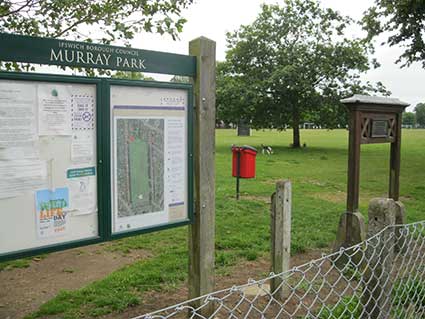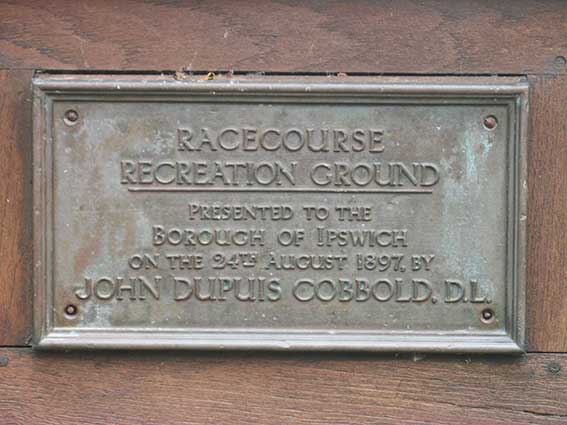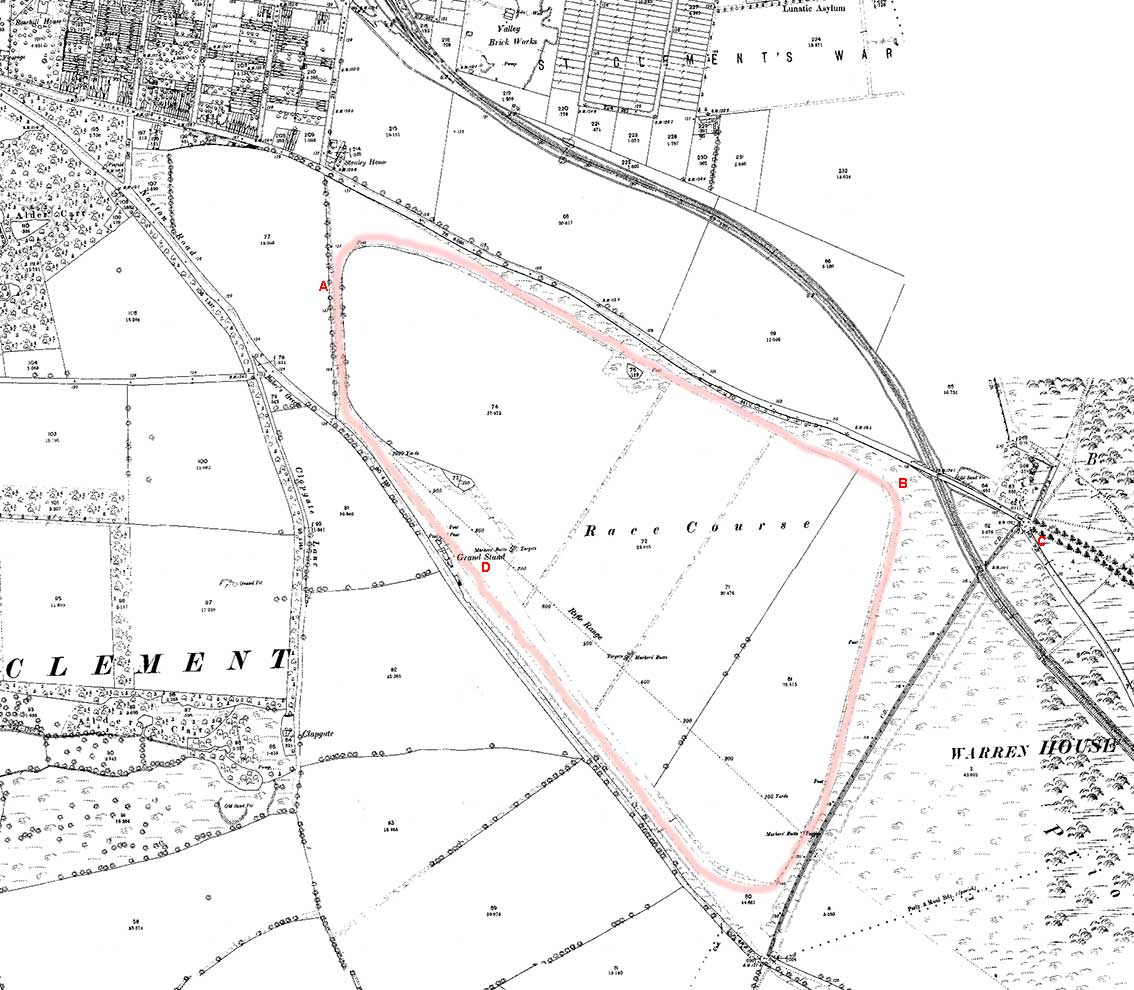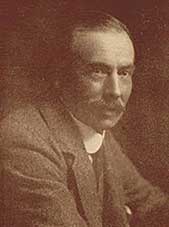Racecourse Recreation Ground


At the north entrance to Murray Park on Murray Road is a timber
structure with rainproof zinc above. The cast metal plaque proclaims
the original name: 'Racecourse Recreation Ground'. See
our Street name derivations page for
the Cobbold-related source of the name 'Murray Road'.
 2019 images
2019 images
‘RACECOURSE
RECREATION GROUND
PRESENTED TO THE
BOROUGH OF IPSWICH
ON THE 24TH AUGUST 1897, BY
JOHN DUPUIS COBBOLD D.L.*’
[* Deputy Lord-Lieutenant of Suffolk]
The area was once Nacton Heath, site of the Ipswich
racecourse; this eventually gave the name 'Racecourse'
to the housing development of the 1930s. The Racecourse public house
was opened at the same time and stood close to the site of the
winning-post. Since its demolition in 2008 to make way for a
supermarket there was scarcely a trace of the original name. Apart,
that is, from the above plaque. These days we tend to
think of the area as an extension of the Gainsborough estate.
 pre-1900
map
pre-1900
map
The above map from pre-1900 shows the circuit of the racecourse (in
pink), lying in the 'V'-shape between Felixstowe Road (above) and
Nacton Road (below). Letters in red: A= the eastern side of the future
Hatfield Road linking those two roads. B= the turn which was to be
followed by the line of the future Cobham Road (home of today's Ipswich
Transport Museum, see Links) and Lindbergh
Road. C= the future site of the Church
of St Augustine (built 1927). D= the 'Grand Stand' of the racecourse at
the winning-post, close to the eventual site of the Racecourse public
house, across Nacton Road.
Hatfield Road. Margaret Hancock tells us: 'The Freehold
Land Society involvement in area started with auction of 'Chestnut
Field Estate' – 250 plots of building land – in July 1890. In the FLS
archive is copy of sale particulars and plan ... It seems that either
at auction, or shortly after, FLS purchased a small block of plots
between what are now Hatfield Road and Levington Road and in 1899/1900
built and ballotted: a) Sirdar Terrace (see House
name derivations), 9 houses fronting Hatfield Road (Nos 26 - 42);
b) 4 pairs of semi-detached villas fronting Levington Road (Nos 45 - 59
inclusive, named Durban, Eastcourt, Belmont and Colenso Villas).'
Note also that Colonel Tomline's Westerfield
Junction to Felixstowe Docks railway line (opened in 1877)
carefully skirts the racecourse.
John Norman takes up the story in one of his notable Ipswich Icons columns in the local
press (27.1.2015):-
'Horse racing had been taking place here since 1710 when riders
competed for the Town Cup, prize money £40, but it was formally
recognised as a proper course in 1727. During those early years the
course grew to become more established and recognised. Initially it was
a simple race between stakes set out across the heath. There was no
attempt to prepare the course, fill the rabbit holes or remove the
gorse bushes but in 1727 the course was awarded ‘The Royal Plate’, a
race worth 100 guineas to the winner. Sometimes referred to as the
King’s Plate, the course required careful preparation, definitive
marking and a level surface on which the horses could run without
stumbling.
The course was on the area of land between Felixstowe and Nacton Roads,
a circuit of some two miles. Starting along the line of what is today
Lindbergh Road, into Cobham Road and then running parallel to
Felixstowe Road towards town. The runners would turn at Hatfield Road
and finish alongside Nacton Road, close to where the shops are today.
The Royal Plate gave meetings credibility and the crowds increased
substantially. A grandstand was built and an advertisement placed in
the Ipswich Journal: “The public are respectfully informed that a
complete and elegant stand is now finished, with an inscription ‘The
Gentlemen’s Stand’, admission: two shillings and sixpence each.”
In the latter half of the 18th Century popularity decreased slightly
until the garrison came to Ipswich (in preparation for the Napoleonic
Wars). Race meetings were particularly well-attended by cavalry
officers who would compete as well as watch.
There is a story that the very first steeplechase took place between
cavalry officers over a scratch course across Nacton Heath to St
Martin’s, Orwell Park and back. Suffolk church towers are, confusingly,
often called steeples. So, in 1803, officers of the 7th Hussars decided
on a moonlit night to race from their barracks in Ipswich to Nacton
Church steeple. Supposedly wearing night caps and white gowns so they
could be seen, the officers terrorised the villagers with their clatter
in deciding which horse was the best. Thus the “steeplechase” was born.
The Ipswich racecourse could accommodate different types of races,
flat, hunt and over the sticks (or hurdles). Hunt racing was designed
to emulate open country fox hunting with the necessity to jump over
hedges at field-width intervals. Younger and less experienced horses
were expected to race over hurdles but these were unpopular both with
jockeys and the horses. All too frequently the horse would refuse and
turn and run across the front of the jump unseating the jockeys of the
other horses. A day at the races included sideshows and booths selling
food and catchpenny amusements (much like the Epsom Derby today). In
1795 the sideshows included a menagerie with elephant and other exotic
animals. It is likely that this was the first elephant to visit Ipswich.
Winning was all important to the owner and jockey but for spectators
betting on the outcome of the race was the most significant activity on
the course. This created a whole new industry of bookmaking. The
bookmaker would offer ever-changing odds on each horse and enter the
bet (and the potential winnings) in his ‘book’. The idea was that he
could see at a glance his income (the bets placed on various horses)
and the likely payout, particularly if the favourite won.
Horse racing continued at Nacton Road until 1911 when the ground was
sold to Ipswich Corporation who built the estate after the First World
War.'

John Dupuis Cobbold DL JP (born
1861 at The Cliff (later The Brewery Tap), Ipswich; died 1929 at Holy
Wells, Ipswich)
One of the lesser known members of the famous Ipswich brewing
family, John Dupuis Cobbold was educated at Eton from 1874 to 1879. He
won the Rackets singles in 1878, the doubles in 1878-9, and the Public
Schools Challenge Cup (1878 with C.A.C. Ponsonby). He was Keeper of
Rackets (1878-79), and also an excellent tennis player. He went up to
Trinity College, Cambridge where he took his BA in Law in 1883.
He was an Hon. Lt. Col. 1st.(Volunteer Battalion) Suffolk Regiment. His
(London) town residence was 34 Cadogan Square and he sold the Holywells
estate in 1929 shortly before he died. He is said to have travelled
exstensively in the USA, Canada, India, Kashmir, Central Asia, Russia,
The Caucasus and Asia Minor. He was a member of the Ipswich Fine Art
Club from 1913 to 1928, although apparently he never exhibited. He was
buried at the Church of St Martin, Trimley St Martin, Suffolk. The
plaque displayed at the park indicates that Felix Thornley Cobbold (see
Christchurch Park & Mansion) wasn't
the only member of the family to be philanthpic towards Ipswich.
[The above includes a portrait and information from the Cobbold Family History Trust
website (see Links).]
Home
Please email any comments and contributions by clicking here.
Search Ipswich
Historic Lettering
©2004 Copyright
throughout the Ipswich
Historic Lettering site: Borin Van Loon
No reproduction of text or images without express written permission


 2019 images
2019 images pre-1900
map
pre-1900
map